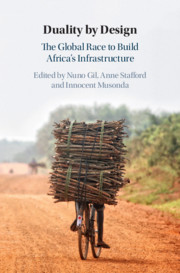Book contents
- Reviews
- Duality by Design
- Duality by Design
- Copyright page
- Contents
- Figures
- Tables
- Contributors
- Foreword
- Acknowledgements
- 1 Duality by Design: The Global Race to Build Africa’s Infrastructure
- Part I Mitigating Institutional Voids by Design
- Part II Exploiting Institutional Voids by Design
- 11 Kenya’s Madaraka Express: An Example of the Decisive Chinese Impulse for African Mega-Infrastructure Projects
- 12 No One-Size-Fits-All Organisational Solution: Learning from Railway Developments in South Africa and Ethiopia
- 13 Building Institutions or Capital Investment? Organisational Duality in the Pursuit of Socio-Economic Development
- Afterword
- Index
- References
13 - Building Institutions or Capital Investment? Organisational Duality in the Pursuit of Socio-Economic Development
from Part II - Exploiting Institutional Voids by Design
Published online by Cambridge University Press: 14 November 2019
- Reviews
- Duality by Design
- Duality by Design
- Copyright page
- Contents
- Figures
- Tables
- Contributors
- Foreword
- Acknowledgements
- 1 Duality by Design: The Global Race to Build Africa’s Infrastructure
- Part I Mitigating Institutional Voids by Design
- Part II Exploiting Institutional Voids by Design
- 11 Kenya’s Madaraka Express: An Example of the Decisive Chinese Impulse for African Mega-Infrastructure Projects
- 12 No One-Size-Fits-All Organisational Solution: Learning from Railway Developments in South Africa and Ethiopia
- 13 Building Institutions or Capital Investment? Organisational Duality in the Pursuit of Socio-Economic Development
- Afterword
- Index
- References
Summary
This inductive study proposes a duality in the design of organisations set up to pursue socio-economic development. Dualities exist when organisations pursue objectives that are jointly desirable, but difficult to reconcile. We ground the research on a sample of inter-organisational contexts set up to pursue development by way of improving basic transport infrastructure in two of Africa’s fast-growing cities, Lagos (Nigeria) and Kampala (Uganda). Our findings reveal sharp variation in the way two desirable objectives are prioritised: to build capital public goods and build the local institutions. When the institutional intermediary that brokers resource exchanges is a ‘traditional’ development agency, e.g. the World Bank, the focus is on building institutions.
- Type
- Chapter
- Information
- Duality by DesignThe Global Race to Build Africa's Infrastructure, pp. 378 - 410Publisher: Cambridge University PressPrint publication year: 2019

